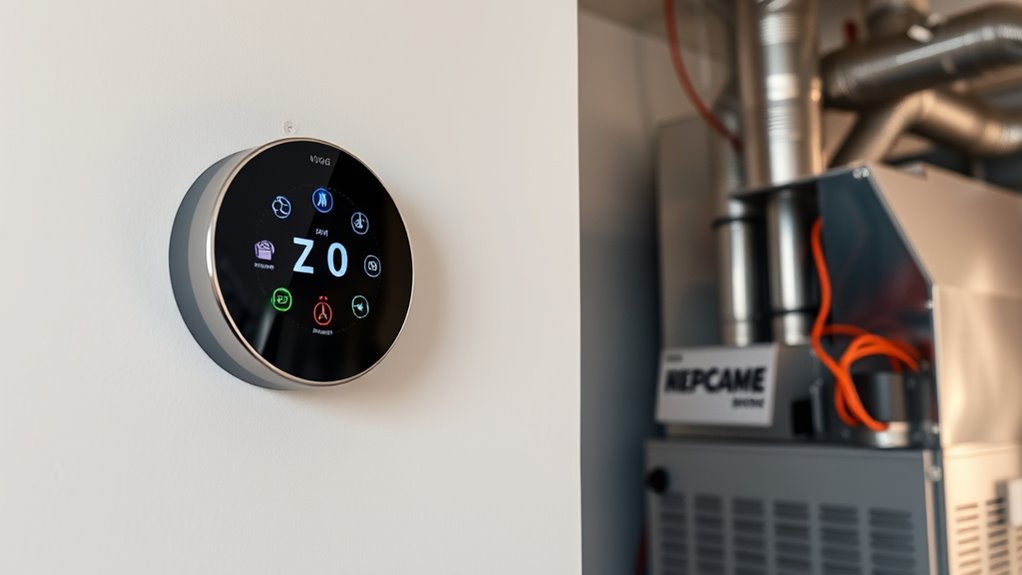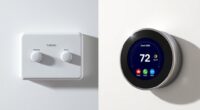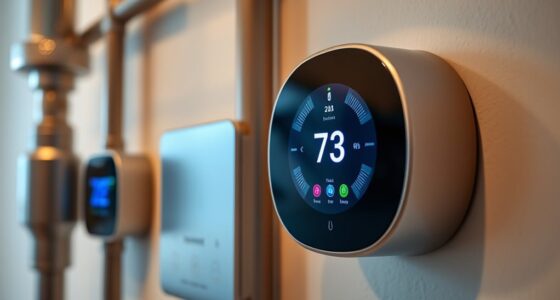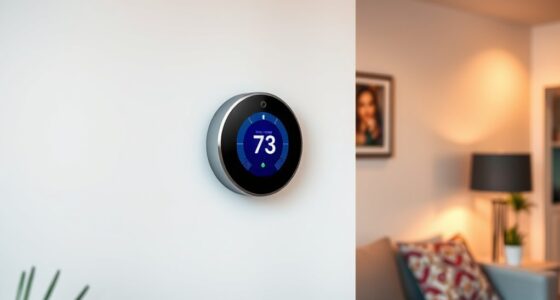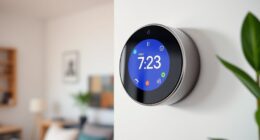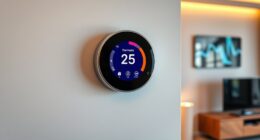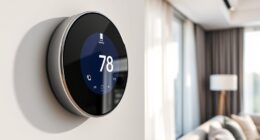To understand if a smart thermostat works with your HVAC system, you need to check your wiring, especially if a C-wire is present, and confirm if your system supports wireless features. Most modern systems are compatible, but complex setups or proprietary controls might need extra steps or professional help. Compatibility also depends on control types and wiring options. Keep exploring to discover how to guarantee your system and new thermostat will work seamlessly together.
Key Takeaways
- Compatibility depends on HVAC wiring, especially the presence of a C-wire, and control system features.
- Most modern systems support smart thermostats, but verify wiring and control protocols beforehand.
- Wireless connectivity options like Wi-Fi, Zigbee, or Z-Wave are essential for remote and integrated control.
- Installation complexity varies; simple replacements are straightforward, while complex systems may need professional setup.
- Check manufacturer specifications to ensure your HVAC system’s wiring and control interfaces align with the thermostat’s requirements.
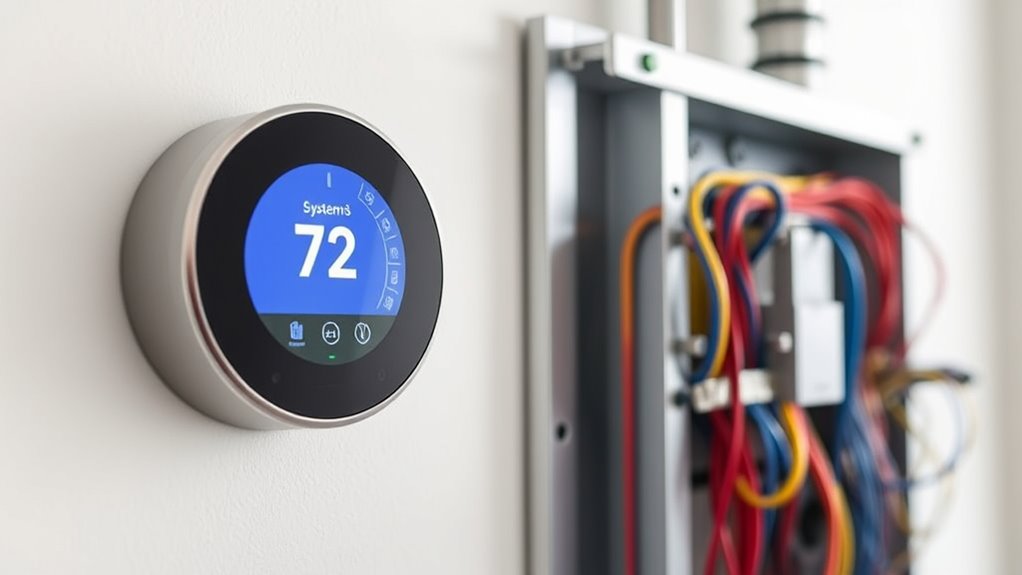
Are you wondering whether your current HVAC system can work with a smart thermostat? The good news is that many modern systems are compatible, but it’s vital to understand the specifics before making a switch. Compatibility mainly depends on your HVAC system’s existing wiring, control features, and the wireless connectivity options available. Most smart thermostats rely on Wi-Fi to connect to your home network, allowing you to control your system remotely through an app. Before purchasing, check whether your HVAC system supports the necessary wireless connectivity, and verify that your Wi-Fi network is robust enough for seamless operation. Additionally, some smart thermostats require specific installation requirements, such as a C-wire (common wire) to power the device, especially if your current thermostat runs on batteries or has limited wiring options. If you don’t have a C-wire, some models offer power-stealing technology or come with a power adapter to work without one, but it’s vital to verify this beforehand. The installation process varies depending on your system; simpler setups might involve just replacing the existing thermostat, while more complex systems, like those with multiple zones or proprietary controls, may need professional installation. You’ll want to review the manufacturer’s installation instructions carefully, making sure your HVAC system’s wiring and control interface align with the smart thermostat’s requirements. Understanding the contrast ratio of your system’s control interface can also help you gauge how easily the thermostat will integrate visually with your existing setup. In terms of wireless connectivity, most compatible smart thermostats connect via Wi-Fi, but some newer models also support Zigbee or Z-Wave protocols, which can integrate with home automation systems. Confirm that your existing network supports these protocols if you plan to expand your smart home setup. Also, consider the placement of the thermostat to maximize signal strength; walls, appliances, or other electronic devices can interfere with Wi-Fi signals, impacting your ability to control the thermostat remotely. If your home has thick walls or a large area, you might need a Wi-Fi extender or mesh network to maintain a strong connection.
Frequently Asked Questions
Can I Install a Smart Thermostat Myself or Need Professional Help?
You can do a DIY installation of a smart thermostat if you’re comfortable with basic wiring and follow the setup instructions carefully. However, if you’re unsure about handling electrical connections or your HVAC system is complex, it’s best to seek professional assistance. Professional help ensures safe installation, proper compatibility, and maximum performance, reducing the risk of damage or incorrect setup. Always assess your skills before attempting a DIY installation.
How Does a Smart Thermostat Integrate With Existing HVAC Systems?
Your smart thermostat seamlessly integrates with your HVAC system, like a puzzle piece clicking into place. It connects wirelessly via Wi-Fi, allowing you to control it from anywhere, and uses your system wiring to communicate with your heating and cooling units. You’ll need to verify your system wiring matches the thermostat’s requirements, but once set up, it’s a game-changer for energy savings and comfort.
Are There Specific Smart Thermostats for Heat Pumps or Radiant Heating?
Yes, there are specific smart thermostats designed for heat pumps and radiant heating. These thermostats offer heat pump compatibility, ensuring efficient control and energy savings. For radiant heating, look for thermostats labeled as radiant heating thermostats since they’re tailored for precise temperature management. Make sure to check compatibility with your system before purchasing, as some smart thermostats work better with certain types of heating systems.
What Are the Energy Savings Advantages of Compatible Smart Thermostats?
Using compatible smart thermostats boosts your energy efficiency by optimizing heating and cooling cycles, which reduces wasted energy. This not only helps you lower your utility bills but also contributes to cost reduction over time. You gain better control over your HVAC system, enabling you to set schedules and adjust temperatures remotely. Overall, smart thermostats make your home more energy-efficient and save you money while maintaining comfort.
Can I Control My Smart Thermostat Remotely via Smartphone or Voice?
Yes, you can control your smart thermostat remotely via your smartphone or voice. With remote access, you can adjust settings, check temperatures, and schedule your HVAC from anywhere. Voice control lets you change the temperature or turn systems on and off using devices like Amazon Alexa or Google Assistant. This convenience helps you stay comfortable and save energy, no matter where you are.
Conclusion
Think of your HVAC system and smart thermostat as dance partners — they need to move in sync for a seamless performance. By understanding their compatibility, you set the stage for a harmonious relationship that boosts comfort and efficiency. Don’t rush the process; take the time to find the perfect match. When they work together smoothly, it’s like a well-choreographed ballet, transforming your home into a haven of perfect climate control.
